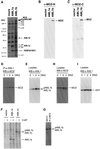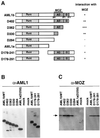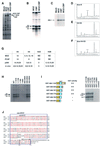Activation of AML1-mediated transcription by MOZ and inhibition by the MOZ-CBP fusion protein
- PMID: 11742995
- PMCID: PMC125775
- DOI: 10.1093/emboj/20.24.7184
Activation of AML1-mediated transcription by MOZ and inhibition by the MOZ-CBP fusion protein
Abstract
The AML1-CBF beta transcription factor complex is the most frequent target of specific chromosome translocations in human leukemia. The MOZ gene, which encodes a histone acetyltransferase (HAT), is also involved in some leukemia-associated translocations. We report here that MOZ is part of the AML1 complex and strongly stimulates AML1-mediated transcription. The stimulation of AML1-mediated transcription is independent of the inherent HAT activity of MOZ. Rather, a potent transactivation domain within MOZ appears to be essential for stimulation of AML1-mediated transcription. MOZ, as well as CBP and MOZ-CBP, can acetylate AML1 in vitro. The amount of AML1-MOZ complex increases during the differentiation of M1 myeloid cells into monocytes/macrophages, suggesting that the AML1-MOZ complex might play a role in cell differentiation. On the other hand, the MOZ-CBP fusion protein, which is created by the t(8;16) translocation associated with acute monocytic leukemia, inhibits AML1-mediated transcription and differentiation of M1 cells. These results suggest that MOZ-CBP might induce leukemia by antagonizing the function of the AML1 complex.
Figures









References
-
- Borrow J., et al. (1996) The translocation t(8;16)(p11;p13) of acute myeloid leukaemia fuses a putative acetyltransferase to the CREB-binding protein. Nature Genet., 14, 33–41. - PubMed
-
- Carapeti M., Aguiar,R.C.T., Goldman,J.M. and Cross,N.C.P. (1998) A novel fusion between MOZ and the nuclear receptor coactivator TIF2 in acute myeloid leukemia. Blood, 91, 3127–3133. - PubMed
-
- Chaffanet M., Gressin,L., Preudhomme,C., Soenen-Cornu,V., Birnbaum,D. and Pebusque,M.-J. (2000) MOZ is fused to p300 in an acute monocytic leukemia with t(8;22). Genes Chromosomes Cancer, 28, 138–144. - PubMed
-
- Champagne N., Pelletier,N. and Yang,X.J. (2001) The monocytic leukemia zinc finger protein MOZ is a histone acetyltransferase. Oncogene, 20, 404–409. - PubMed
-
- Chen H., Lin,R.J., Schiltz,R.L., Chakravarti,D., Nash,A., Nagy,L., Privalsky,M.L., Nakatani,Y. and Evans,R.M. (1997) Nuclear receptor coactivator ACTR is a novel histone acetyltransferase and forms a multimeric activation complex with P/CAF and CBP/p300. Cell, 90, 569–580. - PubMed
Publication types
MeSH terms
Substances
LinkOut - more resources
Full Text Sources
Other Literature Sources
Molecular Biology Databases

